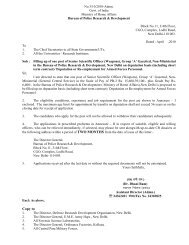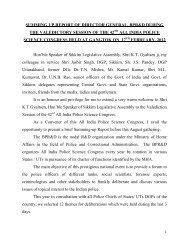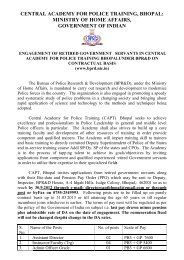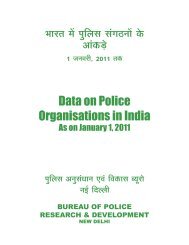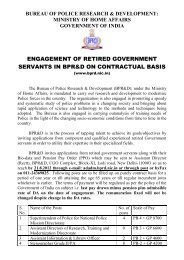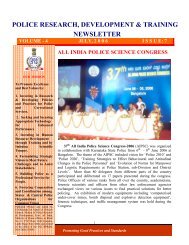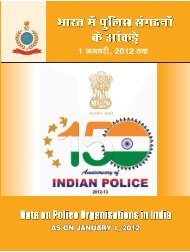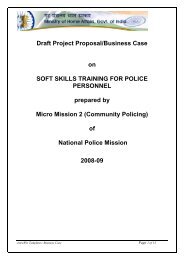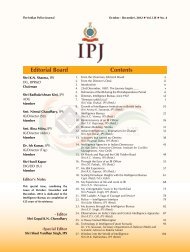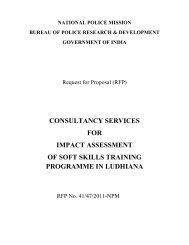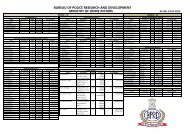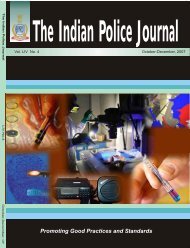April - June 2010 - Bureau of Police Research and Development
April - June 2010 - Bureau of Police Research and Development
April - June 2010 - Bureau of Police Research and Development
- No tags were found...
You also want an ePaper? Increase the reach of your titles
YUMPU automatically turns print PDFs into web optimized ePapers that Google loves.
IntroductionSingapore Community PolicingExperimentSingapore is the most dramatic instance <strong>of</strong> a majorpolice force deciding in a short period <strong>of</strong> time that itwanted to change its fundamental system fordelivering police service, <strong>and</strong> is successfully doingso. Since 1981, Singapore police have shifted fromreactive incident-driven policing to full-scalecommunity policing. Earlier system was largelyreactive <strong>and</strong> based on deployment <strong>of</strong> a large number<strong>of</strong> patrol vehicles.Singapore is a developed nation <strong>and</strong> like the UnitedStates a melting pot <strong>of</strong> diverse races <strong>and</strong> cultures.Its population is 76% Chinese, 15% Malaya, 6%Indians <strong>and</strong> 3% other races. Like New York <strong>and</strong>London, Singapore is one <strong>of</strong> the world's majorcommercial, financial <strong>and</strong> trading centres. It issecond to Rotterdam with the number <strong>of</strong> ships callingat its port everyday 2 .Before transition to community policing, policeoperations in Singapore were done at two comm<strong>and</strong>levels–central headquarters <strong>and</strong> dispersedprecincts. Both the headquarters <strong>and</strong> the precinctsperform the functions <strong>of</strong> foot patrolling, criminalinvestigation, control <strong>of</strong> law <strong>and</strong> order situations,etc. Patrolling was r<strong>and</strong>om motorized patrolling <strong>and</strong>supplemented in some areas by bicycle <strong>and</strong> scooterpatrolling.Neighbourhood <strong>Police</strong> Post (NPP)In November 1991, a number <strong>of</strong> Japanese expertswere invited to help implementation <strong>of</strong> COBANSankar Sen*system in Singapore. On the recommendation <strong>of</strong> thestudy team, 8 NPPs were established in 1983 as apilot to assess the impact <strong>of</strong> the system. Positivepublic response to the NPP led to the acceleration <strong>of</strong>the final implementation phase, ending in December1994. There were now 91 NPPs throughout theisl<strong>and</strong>. Singapore redeployed personnel into NPPsby reducing the number <strong>of</strong> <strong>of</strong>ficers assigned tomotorize petrol <strong>and</strong> reducing the number <strong>of</strong> supportunits, <strong>and</strong> by dissolving precinct task forces. Thepurpose <strong>of</strong> the system is as follows: To improve police-community relations inSingapore. To prevent <strong>and</strong> suppress crime through the cooperation<strong>of</strong> <strong>and</strong> support from the community<strong>and</strong> To project a better police image <strong>and</strong> winconfidence <strong>of</strong> the public in the police with morecommunity-oriented services.StaffingAfter years <strong>of</strong> carefully studying, Singapore policedecided to staff each NPP with 20.5 <strong>of</strong>ficers-4 teams<strong>and</strong> 4 constables <strong>and</strong> corporals. Four sergeantssupervised the teams with an inspector in charge.These teams serve respective 8 hours when the4th team has a rest day. All <strong>of</strong>ficers serve in NPPssometime in their careers but preference is givento good <strong>of</strong>ficers who are keen to serve in this kind<strong>of</strong> assignment. Since 1993 all recruits undergo asix weeks training course in the NPPs. In Singapore1Jerome H. Skolnick <strong>and</strong> David H. Bayley, “Community Policing: Issues <strong>and</strong> Practices Around the World” (Washington, D.C.:National Institute <strong>of</strong> Justice, forthcoming, 1988)2Model <strong>of</strong> Community Policing: The Singapore Story. The US Department <strong>of</strong> Justice.Key WordsCommunity Policing,Japanese Model,R<strong>and</strong>om PatrollingCOBAN,Neighbourhood PolicyPost (NPC)*Senior Fellow, Institute <strong>of</strong>Social Sciences, Vasant Kunj,New Delhi-110070The Indian <strong>Police</strong> Journal Vol. LVII-No. 2, <strong>April</strong>-<strong>June</strong>, <strong>2010</strong> 13➢




